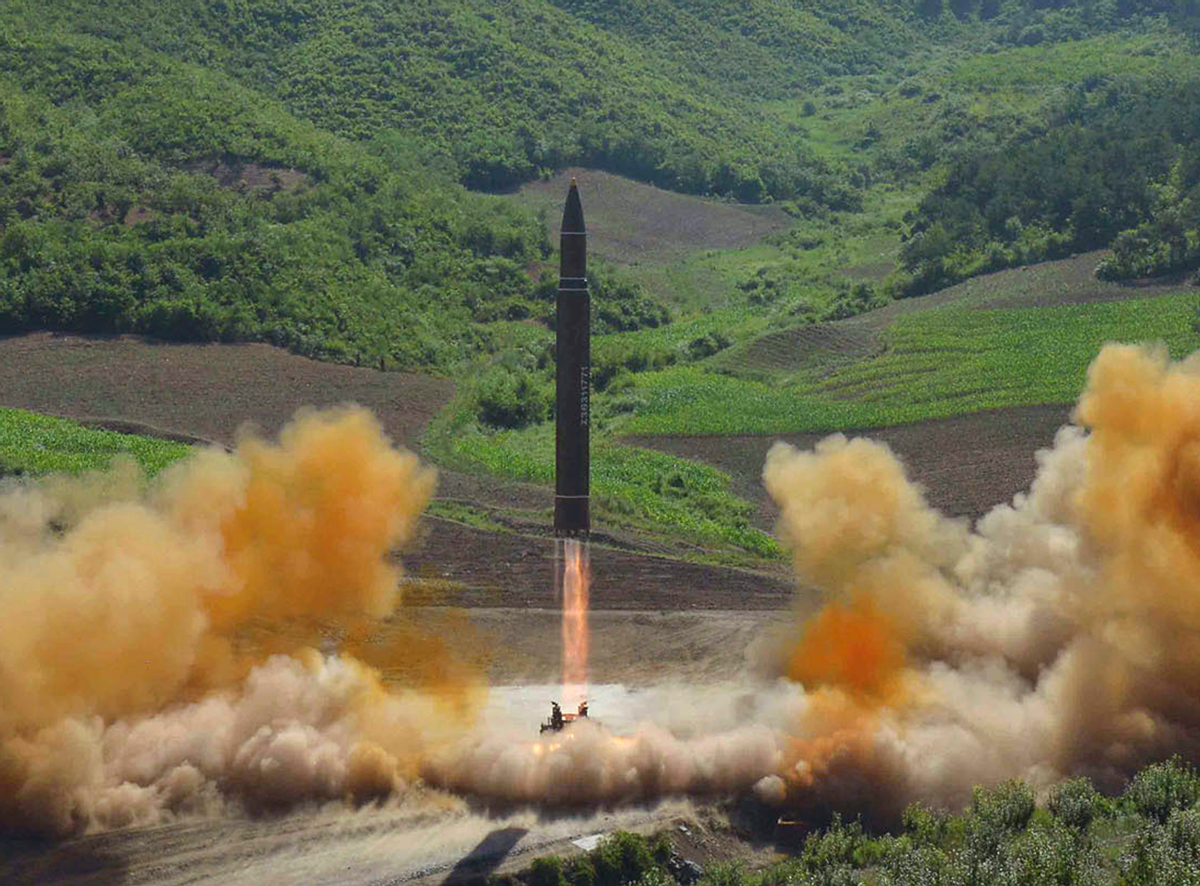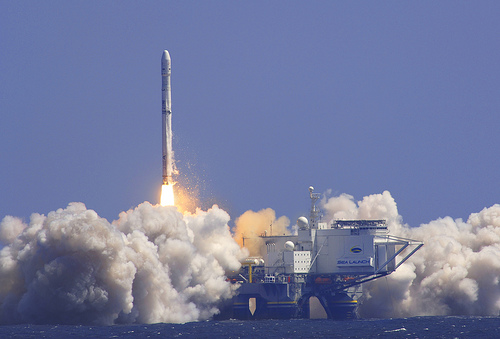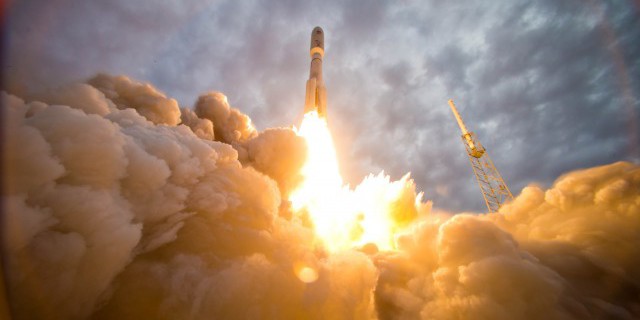On Monday, August 14th, the American edition of The New York Times published an article stating that North Korea bought rocket engines on the black market "probably from a Ukrainian factory with historical links to Russia’s missile program."
This allegation has already been officially denied by the "Ukrainian factory" itself - the "Makarov South Machine Building Plant," better known as Yuzhmash, as well as by the State Space Agency of Ukraine, to which the enterprise is subordinate, and by the National Security and Defence Council Secretary Oleksandr Turchynov.
The editorial board of the Ukrainian IT outlet AIN.UA analyzed the text of The New York Times article, the sources on which it relies, and laid out why the article should not be trusted. Euromaidan Press offers you an English translation.
Introduction. What's the problem, anyway?
At issue is the North Korean nuclear program, or more precisely its missile component. The atomic bomb has been at the disposal of North Korea since 2006, but it did not have effective means of delivering it. For a long time, North Korea has been working on missiles capable of carrying nuclear charges. Until this year, the country had at its disposal only short-range and medium-range missiles capable of reaching South Korea, Japan, and American bases in Guam. But attempts to create an Intercontinental ballistic missile (range over 5,500 km), capable of hitting targets in the continental US, have consistently failed. Finally, over the past year, North Korea made rapid progress and on 4 July 2017 successfully tested the Hwasong-14 ICBM.

Why does The New York Times claim that Ukraine's Yuzhmash plant is associated with this?
First, we need to understand what the NYT article is based on. This is not an investigation of the paper itself. The article cites “an expert analysis being published Monday and classified assessments by American intelligence agencies." These classified assessments are mentioned but not elaborated on or quoted.
But the "expert analysis" is in the public domain. The article is "The secret to North Korea’s ICBM success," published by the British non-profit International Institute for Strategic Studies. Its author is Michael Elleman, an American scientist who originally worked at Lockheed Martin, but also engaged as a missile expert at the UN and other public and private organizations. NYT journalists also must have spoken directly to Elleman, since they cite several of his quotes that are not in the IISS article.
Analysis of the NYT article
Comparison of balance in the IISS source and in the article
The first paragraphs of the NYT article of the IISS study already differ in their judgments, and this difference will persist until the end of both texts.We will mark quotations from The New York Times in yellow, and the quotations from the main source (Michael Elleman's IISS study) - in blue.
The NYT authors argue that the success of the North Korean program "made possible by black-market purchases of powerful rocket engines probably from a Ukrainian factory with historical ties to Russia’s missile program." Journalists point only to the Ukrainian source, but the first paragraph of the article on IISS, which is referred to in the NYT is not so categorical. "Michael Elleman shares the first solid evidence that North Korea has acquired a high-performance liquid-propellant engine from illicit networks in Russia and Ukraine," the editorial introduction states. Elleman further writes in his second paragraph that "the engines were probably acquired through illicit channels operating in Russia and/or Ukraine."
Later in the text of IISS study, Russia and/or Ukraine are associated with engines that have come to North Korea eight times. In six of them they are considered as equal possibilities. At one point, Elleman connects the model of engines, which he identified, only with Russia. "[...] all of them are associated with the Russian enterprise named after V.P. Glushko, now known as Energomash." Only in one of the last paragraphs, Elleman points exclusively to Yuzhmash.
But in the NYT article, neither Ellemann himself in his comments to paper nor the journalists of the publication have presented the information in such a balanced way. “It’s likely that these engines came from Ukraine — probably illicitly,” Mr. Elleman said in an interview. “The big question is how many they have and whether the Ukrainians are helping them now. I’m very worried,” the analyst told the journalists.
[Tweet from Elleman’s now deleted account]:
Not misquoted, but my written words best reflect my findings. I DO NOT allege Ukr gov’t involved; xfer is work of Rus/Ukr smugglers
— Mike Elleman (@Elleman_IISS) August 14, 2017
In the NYT article Ukraine’s “Yuzhmash” is singled out seven times as the source of the engines. The alternative Russian source, "NPO Energomash," is mentioned by the journalists only once.
Step-by-step scrutiny of references and statements
Next, we will analyze the dubious statements and assertions in the NYT article.
1. "Government investigators and experts have focused their inquiries on a missile factory in Dnipro, Ukraine"
In Elleman's study, there is only one passage that can serve as a source for such a proposition: "In addition, Western experts who visited KB Yuzhnoye Ukraine within the past year told the author that a single-chamber version was on display at a nearby university and that a local engineer boasted about producing it."
Elleman does not indicate what was the reason for the visit of these "Western experts" to the Yuzhnoye Design Bureau. Whether the experts “focused their inquiries” or not, was the boast specifically about the engines alleged to be used on the North Korean missiles - no such conclusions can be gleaned from this sentence to support the NYT authors’ wording.
2. "During the Cold War, the factory made the deadliest missiles in the Soviet arsenal, including the giant SS-18. It remained one of Russia’s primary producers of missiles even after Ukraine gained independence. "
The corresponding fragment in the IISS study: "The RD-250 was originally designed by the Glushko enterprise of Russia, and produced and incorporated into the first stage of the R-36 (SS-9) ICBM and the Tsiklon-2 satellite launcher by KB Yuzhnoye of Ukraine. The Tsiklon-2 carrier rocket lofted its first satellite into orbit in 1969, with the last of 106 launches occurring in 2006. While Yuzhnoye was responsible for producing the Tsiklon-2 rocket, Russian entities launched the satellite. The relationship survived the break-up of the Soviet Union in 1991 primarily because of long-standing institutional linkages, and the commercial interests of both enterprises and countries."
As we can see, in the NYT fragment comes off as being about military missiles. But in fact, the IISS study talks about commercial launches of satellites. The model of such collaboration between enterprises in Russia and those based in Dnipro was used for the Sea Launch project with the Zenit launch vehicle, as well as the RS-20 rocket conversion program in the Dnepr LV produced and launched by the Russian Kosmotras in the past.
Yuzhmash also refutes the statements of journalists: "Yuzhmash not only is not the main producer of missiles for the Russian Federation, but does not supply missiles, their parts and assembly units, including rocket engines. [...] Missiles and missile complexes of military use in the years of Ukraine's independence have not been produced and are not currently being produced by Yuzhmash." It is worth mentioning that on August 27, 2014, the NSDC adopted a decision to stop the export of space technology to Russia.
3. "But since Ukraine’s pro-Russian president, Viktor Yanukovych, was removed from power in 2014, the state-owned factory, known as Yuzhmash, has fallen on hard times. The Russians canceled upgrades of their nuclear fleet. The factory is underused, awash in unpaid bills and low morale. Experts believe it is the most likely source of the engines that in July powered the two ICBM tests."
"If North Korea began its quest to identify and procure a new LPE in 2016, the start of the search would have occurred in the same year Yuzhnoye was experiencing the full impact of its financial shortfalls. This is not to suggest that the Ukrainian government was involved, and not necessarily Yuzhnoye executives. Workers at Yuzhnoye facilities in Dnipropetrovsk and Pavlograd were likely the first ones to suffer the consequences of the economic misfortunes, leaving them susceptible to exploitation by unscrupulous traders, arms dealers and transnational criminals operating in Russia, Ukraine and elsewhere."
The economic difficulties of the Dnipro’s space enterprises after the termination of cooperation with the Russian Federation, the curtailment of the Sea Launch program, the Dnepr program and other activities are the main argument for both the NYT and Ellemen. There are indeed financial difficulties. In 2016, Yuzhmash had an outstanding electricity bill of about UAH 400 million. This debt was repaid by the state after the adoption of amendments to the state budget in 2016 in December (law # 5281). This year the Verkhovna Rada also adopted bill #6600, signed by the President on August 1. In it, Yuzhmash was allocated an additional UAH 50 million to pay off part of the wage arrears.
"Experts believe it is the most likely source of the engines that in July powered the two (North Korean - ed.) ICBM tests." Although the NYT refers to "experts," this passage seems based exclusively on Elleman’s words. Opinions of others on this issue are not mentioned. Elleman himself is not so categorical in his study, as well as his tweets.
[Tweet from Elleman’s now deleted account]:
I don’t believe Ukr gov’t condoned or knew, if the engines were sourced in Ukr. To the contrary, Ukr arrested North Koreans in 2012! 2/2
— Mike Elleman (@Elleman_IISS) August 14, 2017
4. "Bolstering his conclusion, he (Elleman - ed.) added, was a finding by United Nations investigators that North Korea tried six years ago to steal missile secrets from the Ukrainian complex."
"Pyongyang has many connections in Russia, including with the illicit network that funnelled Scud, Nodong and R-27 (Musudan) hardware to North Korea in the 1980s and 1990s. United Nations sanctions imposed on Pyongyang have likely strengthened the Kim regime’s ties to these criminal networks. North Korean agents seeking missile technology are also known to operate in Ukraine. In 2012, for example, two North Korean nationals were arrested and convicted by Ukrainian authorities for attempting to procure missile hardware from Yuzhnoye.”
Ellemann in his text talks about not only an attempt by North Koreans to buy technology from Yuzhnoye, but also about the long-standing relationship of that regime with Russia. In addition, although the attempt to obtain Ukrainian technology did take place, an employee of Yuzhnoye reported it to the Security Service of Ukraine and now the spies are serving their sentence in a Ukrainian prison.
5. "Last month, Yuzhmash denied reports that the factory complex was struggling for survival and selling its technologies abroad, in particular to China. Its website says the company does not, has not and will not participate in “the transfer of potentially dangerous technologies outside Ukraine."
This paragraph is not from the IISS report but rather from a Popular Mechanics article from June 19. In it, referring to his sources, journalist Anatoly Zak asserts that "Chinese officials asked the Ukrainians to rebuild the very original lunar landing propulsion module (developed for the Soviet lunar program - ed.) using modern materials like new computer technology replacing obsolete electronics in the module's flight control system" . Here's how the author of Popular Mechanics piece reacted on Twitter to the NYT article:
They also improperly quote my article which never said that Ukraine had sold anything to North Korea. This is very irresponsible writing.
— Anatoly Zak (@RussianSpaceWeb) August 14, 2017
At least, the NYT correctly reported on the refutation of the Popular Mechanics article by Yuzhmash, which declared that "it does not participate in any negotiations with China regarding cooperation on the lunar program".
6. "Norbert Brügge, a German analyst, reported that photos of the engine firing revealed strong similarities between it and the RD-250, a Yuzhmash model."
In fact, in the publication by Norbert Brügge which The New York Times refers to, the following is said: "It is becoming increasingly likely: The new North Korean engine "Pektusan" is similar to a RD-250 of the KB Glushko."
It is unclear for what reason the NYT journalists replaced Brügge’s statement that the RD-250 is being developed by the company "NPO Energomash" (KB Glushko) with a mention of Yuzhmash. This exact model of engines is in fact developed and manufactured at the Russian "Energomash" enterprise, as can be seen on the company's website. Ukraine’s Yuzhmash also used these engines for the Russian Tsiklon carrier rockets, the last of which was manufactured in 2001. The RD-250 have never been delivered by Yuzhmash outside the civilian Tsiklon program since Ukraine’s independence in 1991.
7. The New York Times article also has some minor issues with sloppiness. "Dnipro has been called the world’s fastest-shrinking city. The sprawling factory, southeast of Kiev and once a dynamo of the Cold War, is having a hard time finding customers."
In this paragraph, journalists refer to a post by an American travel blogger Megan Starr, who described her impressions of her stay in Dnipro. In mentioning it as "the most rapidly declining city," Starr links to a 2012 article in the Business Insider. The latter in turn contains a broken link to a UN study. The link in the article does not work but could have easily been linked to directly after a simple Google search.
Conclusions
Despite one of the authors of this New York Times article being a two-time Pulitzer Prize laureate, it contains many inaccuracies and is characterized by a one-sided exposition of even the main source to which it refers.
At the same time, do not forget that the main source itself - the IISS study by Michael Elleman - is based only on the author's assumptions and reasoning about the possibility that the proposed model of engines (determined by examining similarities in photos) could have come either from Ukraine or from Russia to North Korea. In fact, the author does not provide factual evidence, but merely does not exclude such possibility.
It is worth noting that Yuzhmash, the company singled out by the journalists, has quickly issued a denial in a press release, as have the State Space Agency to which it reports and the secretary of the National Security and Defense Council Turchynov. Yuzhmash could not provide the actual data on the presence of RD-250 engines and other parts on its premises when asked by AIN.UA.





